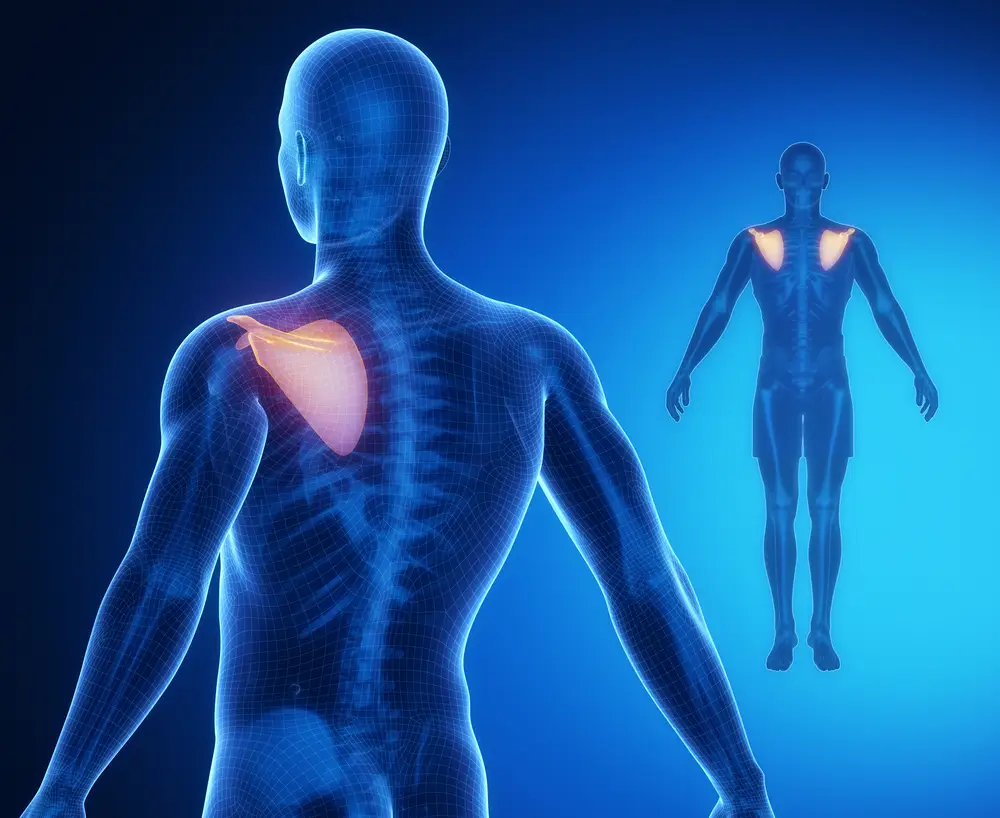Hey everyone! We hope you are keeping well. We’re carrying on with life as close to normal as possible, so here is your monthly reading material. Perfect time for a tea or coffee we say! This month we’re taking a close look at the shoulder, specifically a condition that affects the shoulder blade. Do you have, or have you ever seen someone whose shoulder blades stick out on their back and look a little bit like wings? This condition is aptly named ‘winging’ of the shoulder blades.
Anatomy
Osteopaths love a bit of anatomy! The shoulder blade or ‘scapula’ is a largely flat bone that sits on the back of the rib cage and is an important ingredient in what makes up the various joints of the shoulder. As well as the larger flat part, a few extra lumps and bumps makes for a very odd shaped bone when looked at in isolation. One of the bony protrusions actually makes up the ‘socket’ part of the ball and socket joint in the shoulder. The ‘ball’ part being made from the head of the upper arm bone (aka the ‘humerus’).
Interesting fact… There are 18 muscle attachments on the shoulder blade. It is through fine balancing of these muscles which keeps the shoulder blade stabilised and flush to the back of rib cage, and allows us to move our shoulders through an extremely large range of motion. As you can imagine, keeping all of these muscles in full working order takes a bit of co-ordination. And with so many players involved, there is room for dysfunction to creep in and movement to become affected. Sometimes the dysfunction is great enough to cause the shoulder blade to flip outwards from the rib cage, and this is what we refer to as ‘winging’.
Causes of winging
The causes of shoulder blade winging can be broadly broken down into:
- Muscular: As we previously mentioned, lots of muscles are responsible for controlling the position and movement of the shoulder blade. Injury to these muscles, or an imbalance in the strength, length and function of the muscles over a prolonged period may lead to this issue. The main muscles involved here are the Serratus Anterior (a muscle which attaches to the ribs and the underside of the shoulder blade), and the Trapezius (a kite shaped muscle which covers the back of the neck, shoulders and upper back… Aka ‘traps’). It’s more complex and there are more muscles involved, but these are the key players when it comes to winging.
- Neurological: Muscles require a nerve supply in order to move, so if any of the nerves that supply the key players (i.e. Serratus and Traps) are injured, this can stop the muscles from being able to perform their job. Nerves can be injured through entrapment, where something presses on a nerve as it travels from the spine down to the muscle it supplies. Other causes may be from acute traumas as seen with car or sporting accidents where the shoulder takes a direct blow while the arm or neck are suddenly pulled.
Other ways these injuries may come about include prolonged wearing of a heavy backpack, complications following surgery, or as a result of a viral infection that affects the nerve.
Signs and Symptoms
The main sign is a shoulder blade that doesn’t sit snug to the rib cage, particularly when trying to move the arm upwards in front of the body or out to the side. Many people with scapula winging feel no pain whatsoever, but this can be a very painful condition if the cause is from a severe nerve injury. Another key sign is the inability of a person to lift their arm above their head.
Treatment
The treatment of shoulder blade winging very much depends on the cause. If the shoulder blades are winging because of a muscular imbalance, these are a little easier and faster to rehab. After careful assessment of your shoulder, neck and other spinal movements, we will aim to restore full functioning of the muscles that control the position and movement of the shoulder blades. This might include techniques which aim to lengthen short or tight muscles which are pulling the shoulder blade out of position. If there is a weakness to a particular muscle or group of muscles, we will also prescribe you strengthening and movement re-training exercises which aim to return the shoulder blade to its functional position.
Winging caused from nerve entrapment or injury is notoriously harder to treat. If entrapment of the nerve is caused by muscular tension in another part of the body, or because you’ve been carrying a heavy backpack for too long, then we will work on the relevant muscles and nerves to release the entrapment and pressure. We might also need to adjust how you wear your backpack and how much weight is inside while we focus on improving your physical impairments. Nerve-related injuries can take much longer to resolve. Winging caused by paralysis of the nerve which supplies the Serratus Anterior muscle has been known to take up to two years to resolve. The good news is, most people will make a full recovery in this time with surgical procedures saved only for more complex or unresolved cases. Which if you ask any Osteo, is always the goal!
If you notice winging of the shoulder blades, or difficulty with achieving full shoulder range of motion, then get in touch today on 46555 5588. We would love to chat to you about your issue in a phone or video consult and get you on the road to recovery as soon as possible. You can also book an appointment here.
References
- Brukner, P. et al. 2017. Clinical Sports Medicine. 5th ed. Australia: McGraw Hill Education
- Snell, R. 2012. Clinical Anatomy by Regions. 9th ed. USA: Lippincott Williams & Wilkins
- Magee, D. 2008. Orthopaedic Physical Assessment. 5th ed. USA: Saunders Elsevier







